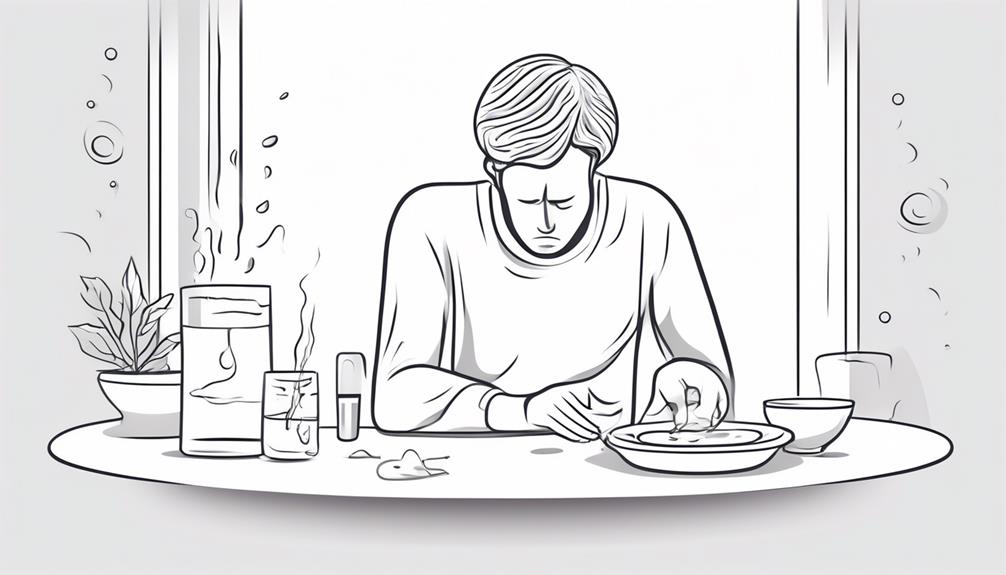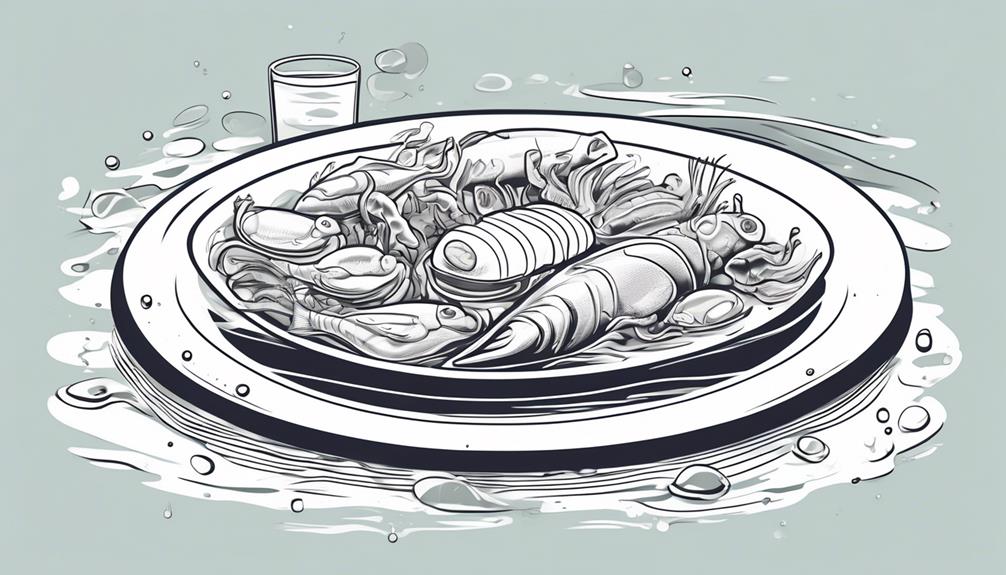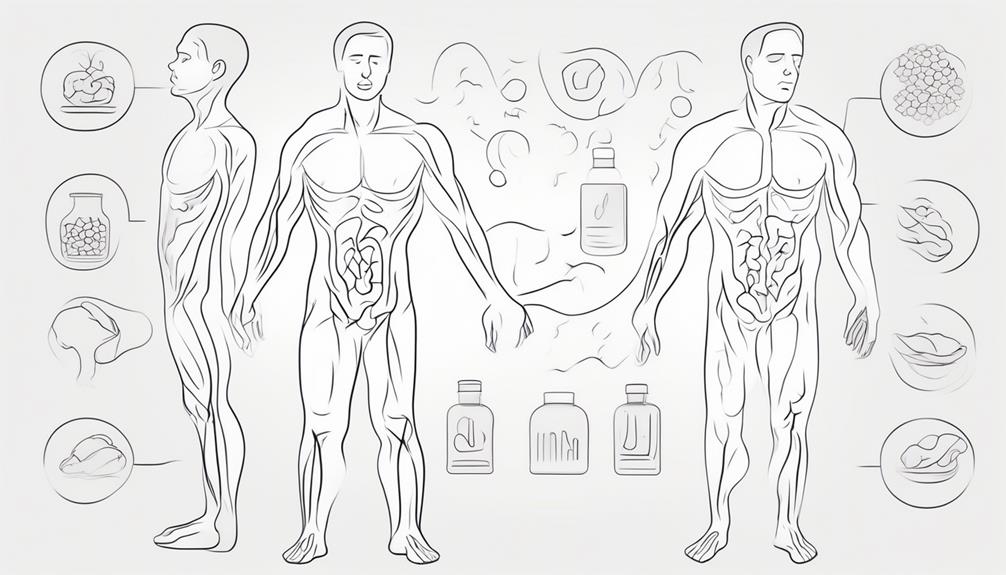Picture this: a seemingly harmless meal that hides a dangerous secret. You might be surprised to learn how common waterborne diseases can be transmitted through contaminated food, lurking beneath the surface of what appears to be a simple dish.
The connection between what you eat and potential health risks is more intricate than you might think. As you navigate through the top waterborne diseases linked to tainted food, you'll uncover a world where pathogens and bacteria play a silent yet powerful role in shaping your well-being.
Stay tuned to discover the risks that may be closer to your plate than you realize.
Key Takeaways
- Salmonella, E. Coli, Campylobacter, Hepatitis A, Norovirus, Giardiasis, and Cryptosporidium are common waterborne diseases linked to contaminated food and water.
- Prevention measures such as proper hygiene, cooking techniques, handwashing, and avoiding cross-contamination are crucial in reducing the risk of contracting these infections.
- Symptoms of waterborne diseases may include diarrhea, cramps, nausea, vomiting, fatigue, and dehydration, underscoring the importance of early detection and treatment.
- Immediate medical attention should be sought for persistent symptoms or suspected cases of severe waterborne infections like cholera and botulism.
Salmonella Infection
Have you ever wondered how Salmonella infection occurs and what its symptoms are? Salmonella is commonly transmitted through contaminated food and water. When raw meat or poultry is improperly handled or cooked, the bacteria can thrive and cause infections when ingested. Symptoms of Salmonella infection often include diarrhea, abdominal cramps, and fever. These symptoms can range from mild to severe, depending on the individual and the amount of bacteria consumed.
Once Salmonella enters your body, it can wreak havoc on your digestive system, leading to dehydration and other complications. The bacteria can also spread to other parts of your body, causing more severe illness. It's crucial to seek medical attention if you suspect you have a Salmonella infection, especially if you experience persistent diarrhea or high fever.
To prevent Salmonella infection, always practice good food hygiene, such as washing your hands and utensils thoroughly, cooking food to the right temperature, and avoiding cross-contamination. By being vigilant and cautious, you can reduce the risk of contracting this unpleasant illness.
E. Coli Outbreaks
Let's talk about E. Coli outbreaks and how to prevent them.
- Coli can have a significant impact on public health, causing serious illness.
E. Coli Prevention Measures
To prevent E. Coli outbreaks, implement strict sanitation practices in food preparation and handling. Proper hygiene and cooking techniques are essential in reducing the risk of contamination. Here are some key prevention measures you can take:
| Prevention Measures | Description | Benefits |
|---|---|---|
| Wash Hands Thoroughly | Wash hands with soap before and after handling food. | Reduces the transfer of bacteria. |
| Cook Meat Thoroughly | Cook meat, especially ground beef, to a safe internal temperature of 160°F. | Kills E. Coli bacteria. |
| Avoid Cross-Contamination | Keep raw meat separate from ready-to-eat foods to prevent bacteria spread. | Minimizes E. Coli transmission. |
Impact on Public Health
Waterborne diseases caused by contaminated food, particularly E. Coli outbreaks, pose significant risks to public health due to the potential for severe illness and widespread contamination. E. Coli bacteria can lead to symptoms like diarrhea, vomiting, and even more severe complications such as kidney failure.
When these outbreaks occur, they can affect not only individuals who consumed the contaminated food but also communities at large through the spread of the bacteria. This contamination can happen in various ways, from improper food handling to contaminated water sources.
It's crucial to prioritize food safety measures to prevent these outbreaks and protect public health. Stay informed, practice safe food preparation, and support regulations that ensure the safety of our food supply.
Hepatitis A Cases
Reports indicate a surge in Hepatitis A cases linked to contaminated food sources. Hepatitis A is a viral infection that affects the liver and can lead to symptoms like jaundice, fatigue, and nausea. The virus is commonly spread through the consumption of contaminated food or water.
Imagine this: You go out for dinner, and a few days later, you start feeling unwell. You might dismiss it as a regular stomach bug, but it could be something more serious like Hepatitis A. The recent increase in cases highlights the importance of food safety and hygiene practices.
To protect yourself, always wash your hands before handling food, ensure that fruits and vegetables are thoroughly cleaned, and cook food to the recommended temperatures. Be cautious when dining out and choose establishments with high food safety standards.
Norovirus Contamination
Contaminated food can transmit the highly contagious Norovirus, causing severe gastrointestinal symptoms. This virus is a leading cause of foodborne illness outbreaks worldwide, affecting millions of people each year.
Here are three key points to understand about Norovirus contamination:
- Rapid Spread: Norovirus can spread quickly in settings where food is handled or prepared improperly. A single infected food handler can contaminate a large batch of food, leading to widespread illness among consumers.
- Symptoms: Norovirus infection commonly presents with symptoms such as nausea, vomiting, diarrhea, and stomach cramps. These symptoms can be sudden and intense, lasting for a few days. Dehydration is a significant concern due to fluid loss from vomiting and diarrhea.
- Prevention: Proper handwashing, thorough cooking of food, and avoiding cross-contamination are crucial in preventing Norovirus contamination. If you suspect food may be contaminated, refrain from consuming it and inform the relevant authorities to prevent further spread of the virus.
Giardiasis Symptoms

Given the risks associated with Norovirus contamination in food, it's essential to be aware of the symptoms of Giardiasis, another waterborne illness that can cause significant health concerns. Giardiasis is caused by a parasite known as Giardia, which is found in contaminated water sources. If you've been infected, you may experience symptoms such as severe diarrhea, stomach cramps, bloating, and nausea. These symptoms can be debilitating and may last for 1 to 2 weeks if left untreated.
Additionally, Giardiasis can lead to weight loss, fatigue, and dehydration due to the constant diarrhea and vomiting. Some individuals may also develop a low-grade fever or experience greasy stools that can float. It's crucial to seek medical attention if you suspect you have Giardiasis, as it can be diagnosed through stool tests and treated with antibiotics. Remember to stay hydrated and avoid consuming untreated water while camping or traveling to prevent this waterborne illness.
Campylobacter Sources
Hey there!
Wondering where Campylobacter comes from? Well, think poultry and livestock, water, and produce.
Be cautious of cross-contamination risks – it's key to keeping those pesky bacteria at bay!
Poultry and Livestock
When considering the sources of Campylobacter in poultry and livestock, it's crucial to understand the potential risks associated with consumption. Here are three key points to keep in mind:
- Contaminated Water: Poultry and livestock can ingest Campylobacter from contaminated water sources, which can then be transmitted to humans through consumption of undercooked meat or poultry products.
- Cross-Contamination: Improper handling of raw poultry and livestock can lead to cross-contamination in the kitchen. Ensure separate cutting boards and utensils are used for raw meat to prevent the spread of Campylobacter to other foods.
- Inadequate Cooking: Insufficiently cooked poultry or livestock products can harbor Campylobacter bacteria. Always cook meat to the recommended internal temperature to kill any harmful bacteria and reduce the risk of infection.
Water and Produce
To further explore the sources of Campylobacter contamination, let's shift our focus to how water and produce can play a role in transmitting these bacteria to humans. Campylobacter can contaminate water sources used for irrigation or washing produce, leading to the spread of these bacteria to fruits and vegetables. When contaminated produce is consumed raw or undercooked, it can result in Campylobacter infection. Below is a breakdown of how Campylobacter can find its way into your produce:
| Source of Contamination | Description | Risk Factor |
|---|---|---|
| Irrigation Water | Water used to hydrate crops can carry bacteria | High |
| Contaminated Soil | Soil containing animal feces can infect produce | Medium |
| Cross-contamination | Improper handling can transfer bacteria to fruits | Low |
Cross-contamination Risks
Cross-contamination of Campylobacter, a common source of foodborne illness, can occur through improper handling practices in food preparation. To prevent the spread of this harmful bacteria, remember these key points:
- Separate: Keep raw meats separate from ready-to-eat foods to avoid cross-contamination. Use different cutting boards and utensils for raw and cooked foods.
- Clean: Wash your hands, surfaces, and utensils thoroughly with soap and water after handling raw meat to eliminate any Campylobacter present.
- Cook: Ensure that poultry, meat, and other animal products are cooked to the proper internal temperature to kill any bacteria, including Campylobacter, that may be present.
Listeriosis Concerns
While Listeriosis is a serious concern, especially for vulnerable populations, staying informed about safe food handling practices is crucial in preventing its spread. Listeriosis is caused by the bacterium Listeria monocytogenes and can lead to severe illness, especially in pregnant women, newborns, older adults, and individuals with weakened immune systems.
Table: Listeriosis Prevention Tips
| Prevention Tip | Description | Example |
|---|---|---|
| Keep raw meat separate from ready-to-eat foods | Prevents cross-contamination of harmful bacteria from raw meat to foods that won't be cooked again | Store raw chicken in a separate drawer from salads |
| Cook foods thoroughly | Kills Listeria bacteria that may be present in the food | Ensure ground beef is cooked to an internal temperature of 160°F |
| Wash hands and surfaces frequently | Reduces the risk of spreading Listeria from contaminated surfaces to food | Wash hands after handling raw meat and before cooking |
Cholera Risks

Hey there!
Let's chat about cholera risks.
To keep cholera at bay, remember to practice good hygiene, especially when it comes to food and water.
If you suspect cholera, seek medical attention promptly for effective treatment.
Cholera Prevention Measures
To protect yourself from cholera risks, practice proper hygiene and safe food handling techniques at all times. Here are three essential tips to help prevent cholera:
- Wash Hands Thoroughly: Always wash your hands with soap and clean water before eating or handling food, and after using the toilet. Proper handwashing can significantly reduce the spread of cholera-causing bacteria.
- Drink Safe Water: Ensure that the water you drink is safe by boiling it or using water purification tablets. Contaminated water is a common source of cholera infections.
- Cook Food Thoroughly: Cook seafood, especially shellfish, and other food items thoroughly before consumption. Proper cooking kills cholera bacteria, reducing the risk of infection.
Cholera Treatment Options
For effective management of cholera risks, understanding the available treatment options is crucial in combating this waterborne disease. When dealing with cholera, prompt treatment is essential to prevent severe dehydration and potential fatality. Here are some common treatment options for cholera:
| Treatment | Description |
|---|---|
| Oral Rehydration | Replacing lost fluids and electrolytes orally |
| Intravenous Fluids | Administering fluids and electrolytes through IV |
| Antibiotics | Shortening the duration and severity of symptoms |
| Zinc Supplements | Reducing the duration of diarrhea |
Cryptosporidium Outbreaks
As Cryptosporidium outbreaks continue to pose a threat, understanding the sources and prevention methods becomes paramount. This parasite is commonly found in water sources and can contaminate food, leading to severe gastrointestinal issues.
To protect yourself and your loved ones from Cryptosporidium outbreaks, consider the following:
- Boil Water: Ensure that any water you use for drinking or cooking is boiled to kill any potential Cryptosporidium parasites present.
- Wash Fruits and Vegetables: Thoroughly wash all fruits and vegetables before consumption, as they can be a common source of contamination if not properly cleaned.
- Avoid Unpasteurized Products: Stay away from unpasteurized dairy products or juices, as these can harbor Cryptosporidium and other harmful pathogens.
Botulism Incidents

Botulism incidents can result from consuming contaminated food products. This serious illness is caused by a toxin produced by Clostridium botulinum bacteria, which can grow in improperly canned or preserved foods. The symptoms of botulism can be severe, including muscle weakness, blurred vision, difficulty speaking, and even paralysis. In some cases, botulism can be life-threatening if left untreated.
To prevent botulism, it's crucial to follow proper food safety practices. When canning foods at home, make sure to use the correct techniques and equipment to avoid bacterial contamination. Be cautious of bulging or leaking cans, as these can indicate the presence of harmful bacteria. Additionally, store perishable foods properly and follow expiration dates to reduce the risk of consuming contaminated products.
In the case of suspected botulism poisoning, seek medical attention immediately. Treatment may include antitoxin administration and supportive care to help manage symptoms and prevent complications. Remember, being informed and proactive about food safety can significantly reduce the chances of botulism incidents. Stay vigilant and prioritize safe food handling practices to protect yourself and your loved ones.
Frequently Asked Questions
How Can Waterborne Diseases Be Prevented in the First Place?
To prevent waterborne diseases, make sure to treat water properly, wash hands frequently, and avoid consuming contaminated food or water. Remember to keep surfaces clean and sanitary, and always follow proper food handling practices.
Are There Any Specific Populations That Are More Susceptible to Contracting Waterborne Diseases?
You may wonder who's more at risk for waterborne diseases. Some populations, like the elderly, children, and those with weakened immune systems, are more susceptible. Taking precautions, like boiling water, can help protect yourself.
Can Waterborne Diseases Be Transmitted Through Physical Contact With Contaminated Food?
Oh, you bet! Waterborne diseases can hitch a ride on contaminated food faster than a cat chasing a laser pointer. Always wash your fruits and veggies thoroughly to avoid an unwanted aquatic adventure.
What Are the Long-Term Effects of Contracting a Waterborne Disease?
Contracting a waterborne disease can lead to long-term health issues such as chronic digestive problems, kidney damage, and even neurological disorders. It's crucial to seek medical help promptly to prevent complications.
Are There Any Emerging Waterborne Diseases That We Should Be Aware of in the Future?
In the future, be aware of emerging waterborne diseases like Cyclospora infections, which have been on the rise. Stay informed about prevention methods and symptoms to protect yourself and your loved ones from potential health risks.
Conclusion
So next time you think about your food choices, remember the risks of waterborne diseases like salmonella, E. coli, hepatitis A, norovirus, giardiasis, listeriosis, cholera, cryptosporidium, and botulism.
Don't let contaminated food ruin your day or your health.
Stay informed, stay safe, and make wise decisions when it comes to what you eat.
Your well-being is worth it.
Stay vigilant, stay healthy.
